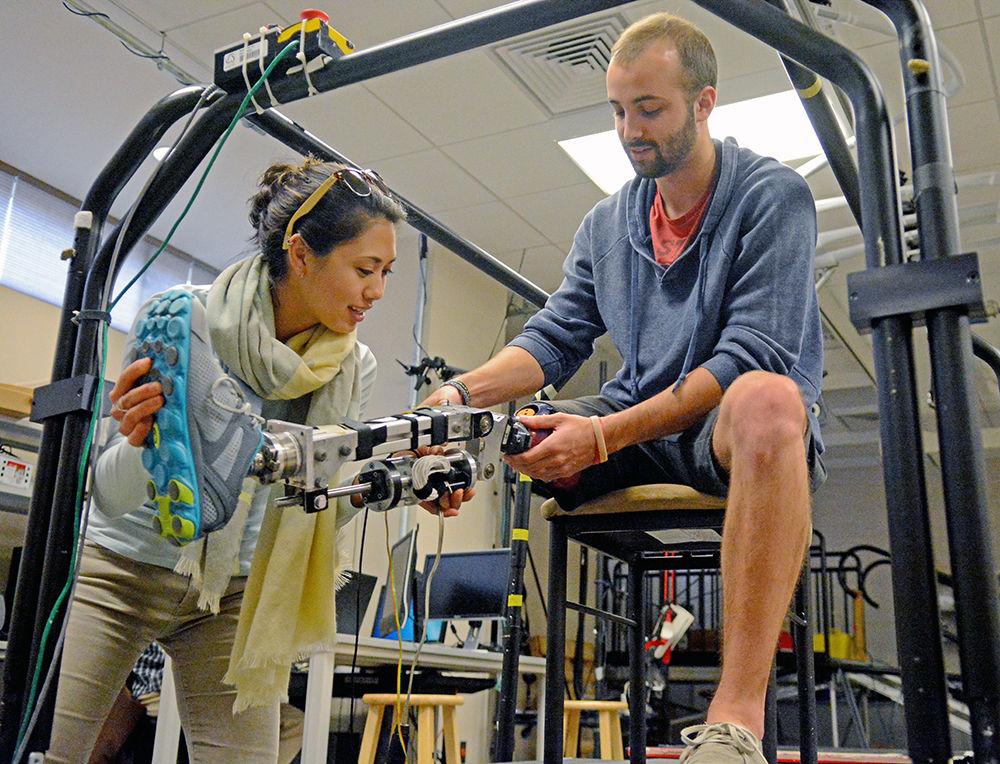Many students may not think about the way their bodies move as they traverse campus everyday. When it feels perfectly natural to swing a backpack over their shoulder, walk uphill on Dan Allen Drive or to carry a finished project to class, most students don’t give these seemingly simple activities much consideration. Andrea Brandt, however, does.
As a Ph.D. student in the NC State and UNC-Chapel Hill Joint Department of Biomedical Engineering, Brandt has spent much of her time in graduate school considering these activities on behalf of amputees. Brandt conducts research on the way prostheses act in real-world situations, with knee prosthetics as the main focus of her research. Specifically, she studies the ways in which they affect the ability of the amputees to carry heavy weight.
“We know that when you put on your backpack [as an able-bodied person], your muscles automatically contract to change the stiffness in your knee,” Brandt said. “You’re changing the mechanics of your knee joint. With current prosthetics on the market, you can’t change the mechanics of the knee.”
Intact muscles will adapt to different situations where weight is carried by the owner, but prosthetics are more stubborn because of the way that they are fitted. Clinicians or prosthetists put new prosthetics on their patients and have them walk around inside the clinic, then they set control parameters based on what they observe there.
“They’ve been trained how to find gait abnormalities when they’re walking, what kind of movements are not preferable and how to minimize those by adjusting the parameters,” Brandt said. “It’s a lot of trial and error.”
These control parameters are adjusted to each patient and allow them to move around the clinic with ease, but the real world poses more of a challenge. Prosthetics cannot adapt in the same way that intact muscles can.
“The limitation that we’re seeing in this process is the parameters that are set inside the clinic are fixed,” Brandt said. “They don’t adjust when [the patients] walk outside the clinic and go about their daily life.”
The solution proposed by the researchers was powered devices which use motors that are more capable in adapting to the varied challenges of everyday life.
“There’s been other load-carriage studies,” Brandt said. “They all show that [amputees] compensate with the intact side [of the leg] because there’s nothing you can do about the prosthetic side. One of the biggest things that we do in this lab is work with powered devices. The motor provides power, and then you’re able to change the mechanics of the knee joint.”
Unfortunately, there is a lack of powered devices on the market. Brandt’s team recruited local amputees to assist in the research and test the prosthetics inside the lab.
“My prosthetist gave me info about the lab,” said Charles Humphries, a third-year studying mechanical engineering and one of the participants in the biomedical research. “I was interested because what they do in this lab is going to help amputees, so why not further the research and help to speed it up?”
Humphries says that there is not as much research done on prosthetic legs as he would like to see. He believes that, at the very least, more research needs to be done on making the prosthetics feel more like a body part and less like a piece of metal.
Brandt believes that the knee is an integral part of holistic health, and she was concerned by the discomfort she noticed in current prosthetics — a need that inspired the research.
“[The idea] came from the limitations of current devices,” Brandt said. “It’s important for balance and safety to have a good knee, a good device that you rely on.”
Brandt studied math during her undergraduate career, but she had always wanted a way to apply this learning in a way that would not just have her sitting in front of a computer. Through her biomedical research, she feels that she has found something meaningful.
“I knew I wanted to apply my skills somehow,” Brandt said. “Seeing that we can work with the end users, the amputees that are going to be using the devices and getting their feedback was a huge motivating factor [in pursuing biomedical engineering] for me.”
Brant said she enjoys being able to help people and having applicable work where she feels like she is making a difference.
“The lab has so many different directions from the design to the control to the application,” Brandt said. “Overall, our mission statement is to improve the lives of people with disabilities, and our focus is on understanding the control mechanisms of our bodies like the central nervous system, and then developing more advanced technology to assist people with disabilities.”
Her future goals are to assist other researchers with her work. Some of her colleagues are currently working on utilizing the central nervous system in prosthetic attachment while others are focused on developing artificial intelligence for the same purpose.
As of now, those interested can get a closer look at her research in “Scientific Reports,” an online, open-source journal.













